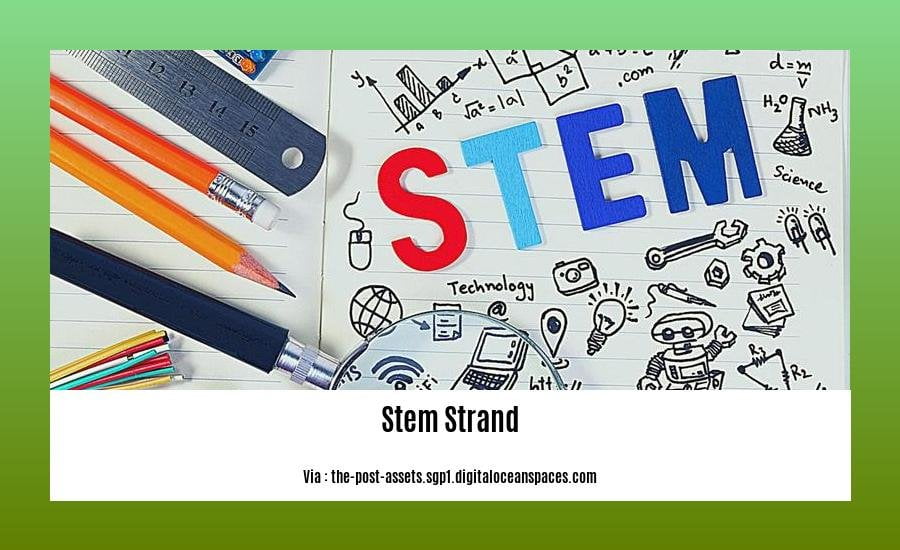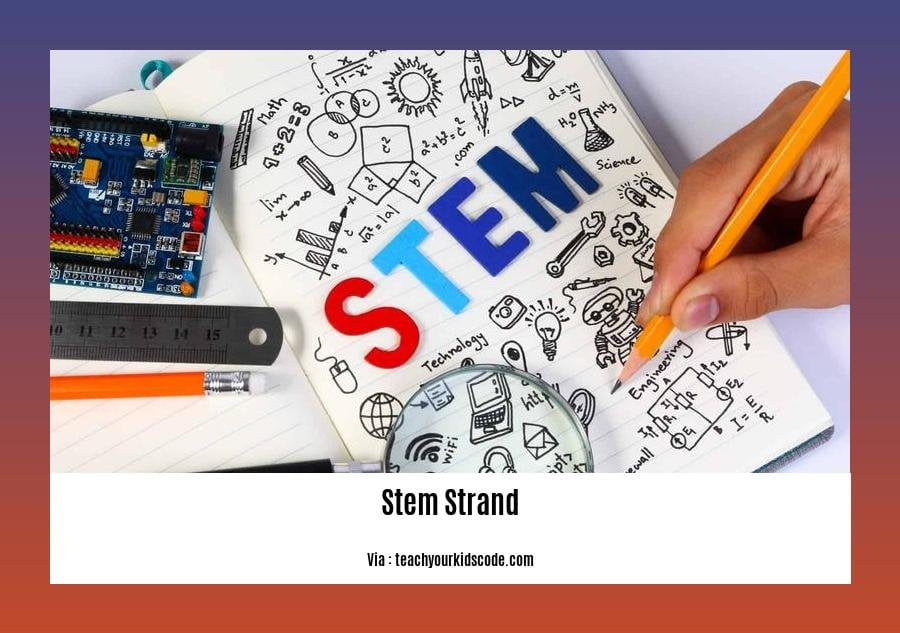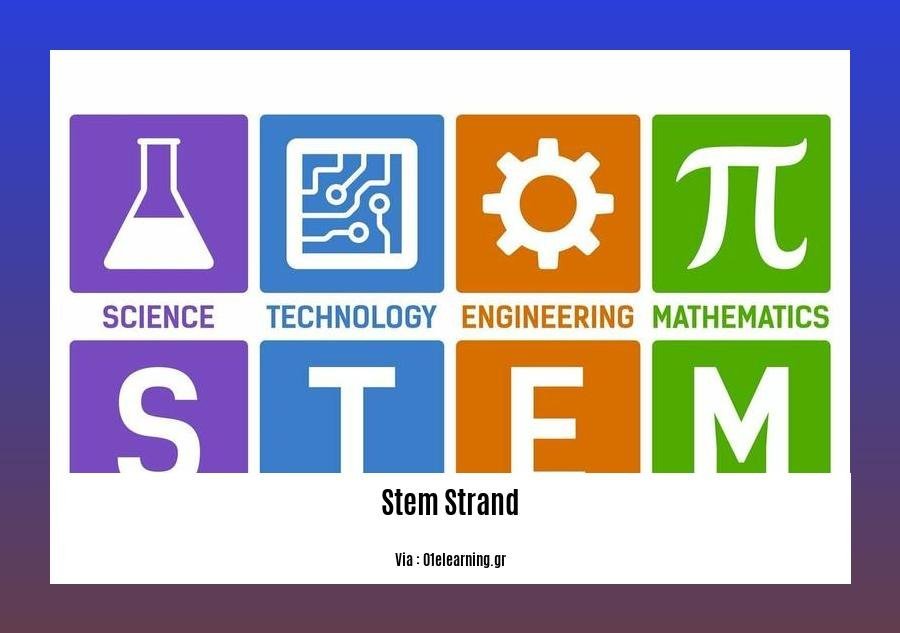If you’re curious about the STEM strand and want to uncover fascinating facts about the science, technology, engineering, and mathematics pathway, you’ve come to the right place. In this article, we’ll delve into the world of STEM and explore its various aspects, from the significance of its disciplines to the exciting opportunities it offers. Get ready to embark on a journey of discovery and gain a deeper understanding of the STEM strand. Let’s dive in!
Key Takeaways:
- The STEM strand in senior high school fosters curiosity, problem-solving abilities, and communication skills.
- Graduates of the STEM strand develop creativity and ingenuity, important for generating new ideas and innovations.
- Students in the STEM strand are inclined to experiment and take risks.
- The STEM strand promotes resilience by providing a safe environment where students can learn from failures.
- Collaboration and teamwork are encouraged in the STEM strand for problem-solving, data recording, report writing, and presentations.
- The STEM strand emphasizes the power and importance of technology in today’s digital age.
Facts about STEM Strand: Exploring the Science, Technology, Engineering, and Mathematics Pathway

The STEM strand in senior high school is a captivating and dynamic field of study that encompasses science, technology, engineering, and mathematics. By diving into the depths of these subjects, students in the STEM strand acquire a wide range of skills that can be applied to various industries and real-world contexts. In this article, we will delve into some fascinating and enlightening facts about the STEM strand.
Fact 1: Nurturing Curiosity, Problem-Solving, and Communication Skills
One of the key objectives of the STEM strand is to nurture students’ curiosity, problem-solving abilities, and communication skills. By engaging in hands-on activities and challenging projects, students are encouraged to think critically, analyze problems from different angles, and come up with innovative solutions. The STEM strand stimulates the mind and fosters the development of essential skills that can be applied not only in the classroom but also in future careers.
Fact 2: Developing Creativity and Ingenuity
Graduates of the STEM strand possess a keener sense of creativity and ingenuity. Through the exploration of science, technology, engineering, and mathematics, students are exposed to a vast array of concepts and theories that stretch their minds and inspire new ideas. The STEM strand instills a mindset of innovation and encourages students to think outside the box, leading to breakthroughs and advancements in various fields.
Fact 3: Embracing Risk-Taking and Experimentation
Students in the STEM strand are more inclined to experiment and embrace risk-taking. They are encouraged to step out of their comfort zones and explore uncharted territories. By taking risks and experimenting, students learn valuable lessons from both successes and failures, fostering resilience and a growth mindset. In the STEM strand, mistakes are seen as opportunities for growth and improvement, allowing students to develop a resilient and adaptable approach to problem-solving.
Fact 4: Collaboration and Teamwork as Key Elements
Collaboration and teamwork are integral components of the STEM strand. In the real world, projects and innovations are rarely accomplished alone. The STEM strand prepares students for this reality by fostering a collaborative environment where they can work closely with their peers. Through collaboration, students learn how to effectively communicate their ideas, compromise, and leverage each other’s strengths. This team-oriented approach not only enhances the learning experience but also mirrors the collaborative nature of professional STEM fields.
Fact 5: Technology’s Power and Importance in the Digital Age
The STEM strand places a high emphasis on the power and importance of technology, especially in today’s digital age. Students develop a deep understanding of how technology is intertwined with science, engineering, and mathematics. They explore cutting-edge technologies, such as robotics, coding, and data analysis, equipping them with the necessary skills to thrive in a technology-driven society. The STEM strand cultivates digital literacy and empowers students to use technology as a tool to address complex problems and make meaningful contributions to society.
Conclusion
The STEM strand opens doors to a world of limitless opportunities. By nurturing curiosity, fostering creativity, promoting collaboration, and recognizing the importance of technology, the STEM strand prepares students for future careers in a rapidly evolving world. Through hands-on activities, critical thinking, and problem-solving, students in the STEM strand embark on a transformative journey that equips them with the necessary skills and knowledge to thrive in diverse STEM fields. As we delve deeper into the fascinating world of science, technology, engineering, and mathematics, the STEM strand continues to shape the minds and lives of future innovators, problem solvers, and leaders.
Here are some fascinating facts to explore:
Fact About Family: Did you know that family bonds play a crucial role in shaping our lives and identities? Discover more about the importance of family connections and the amazing facts associated with them.
Fact About Liverpool: Uncover the hidden gems of Liverpool, from its rich history to its vibrant culture. Learn astonishing facts about this iconic city that will leave you wanting to explore its charm even further.
Facts About Gujarat: Gujarat, a land of diverse cultures and breathtaking landscapes, has an array of astonishing facts waiting to be discovered. Dive into the historical heritage and fascinating traditions of this Indian state and be amazed.
Facts About Veterinarians: Ever wondered what goes into the world of animal care? Explore the incredible facts about veterinarians who dedicate their lives to keeping our beloved pets healthy and happy. Learn about their fascinating job and the impact they have on animal welfare.
These active internal links will lead you to a world of knowledge and captivating information. Enjoy your exploration!
The Various Branches and Disciplines of STEM
STEM education has gained significant attention in recent years, as it aims to integrate science, technology, engineering, and mathematics into a cohesive and interdisciplinary learning experience. This article explores the various branches and disciplines encompassed by the STEM strand, shedding light on the diverse fields that contribute to this multidisciplinary approach to education.
Science
Science forms a cornerstone of the STEM strand, encompassing a wide range of disciplines such as biology, chemistry, physics, and environmental science. By exploring the natural world through observation, experimentation, and data analysis, scientific inquiry fosters critical thinking, problem-solving skills, and an understanding of the fundamental principles that govern the universe.
Technology
Technology plays a pivotal role in our modern society, and its inclusion in the STEM strand reflects its significance. The discipline of technology encompasses computer science, information technology, electronics, and telecommunications. Students in this branch of STEM develop skills in programming, digital literacy, systems thinking, and innovation, preparing them for the ever-evolving digital landscape.
Engineering
Engineering is all about problem-solving and designing solutions that meet the needs of society. It includes disciplines such as civil engineering, mechanical engineering, electrical engineering, and aerospace engineering, among others. Students in this branch of STEM learn to apply scientific and mathematical principles to create, build, and improve technologies, infrastructure, and systems.
Mathematics
Mathematics serves as the foundation for all STEM disciplines, providing the language and tools for quantifying and analyzing our world. Whether it’s algebra, calculus, statistics, or geometry, mathematics is integral to scientific inquiry, technological advancements, and engineering design. Students in this branch of STEM develop critical thinking skills, logical reasoning, and the ability to solve complex problems.
While these branches represent the core disciplines of STEM, it’s important to note that the field is dynamic and ever-evolving. Other branches and interdisciplinary fields, such as bioengineering, data science, environmental engineering, and robotics, continue to emerge and contribute to the broader STEM landscape.
Key Takeaways:
– STEM education integrates science, technology, engineering, and mathematics into an interdisciplinary learning experience.
– The various branches of STEM include science, technology, engineering, and mathematics.
– Science encompasses disciplines such as biology, chemistry, physics, and environmental science.
– Technology includes computer science, information technology, electronics, and telecommunications.
– Engineering comprises disciplines such as civil engineering, mechanical engineering, electrical engineering, and aerospace engineering.
– Mathematics serves as the foundation for all STEM disciplines, providing the language and tools for quantifying and analyzing the world.
– Other branches and interdisciplinary fields continue to emerge and contribute to the broader STEM landscape.
Sources:
– Britannica: STEM | Description, Development, & Facts
– Wikipedia: Science, technology, engineering, and mathematics
The Benefits and Opportunities in Pursuing a Career in STEM

Are you interested in science, technology, engineering, and mathematics? If so, pursuing a career in STEM may be the perfect path for you. Not only does this field offer a wide range of opportunities, but it also provides numerous benefits that can set you up for a successful and fulfilling future.
High Salaries and Job Security
One of the key benefits of pursuing a career in STEM is the potential for high salaries. STEM professionals are in high demand, and their specialized skills and knowledge command competitive compensation. Additionally, these jobs often come with excellent benefits and job security, as the demand for STEM expertise continues to grow across various industries.
Opportunities for Growth and Advancement
STEM careers provide abundant opportunities for growth and advancement. With new discoveries and advancements happening every day, there is always room to expand your knowledge and skills. Whether it’s moving up the career ladder or branching out into different areas of specialization, the possibilities for growth in the STEM field are virtually endless.
Preparation for the Future
STEM education is crucial in preparing students for future careers. In a rapidly changing world, STEM skills are in high demand. By pursuing a career in STEM, you can equip yourself with the necessary skills and knowledge to thrive in the job market of tomorrow. From robotics and artificial intelligence to renewable energy and biotechnology, STEM professionals are at the forefront of innovation and technological advancements.
Holistic Growth and Development
STEM education not only focuses on academic knowledge but also supports the development of social-emotional skills. By engaging in hands-on experiments and collaborative projects, students in STEM fields cultivate essential skills such as self-awareness, empathy, and responsible decision-making. This holistic approach ensures that students grow not only intellectually but also emotionally and socially.
Igniting Creativity and Cultivating Collaboration
Creativity and collaboration are integral to success in STEM fields. STEM education encourages students to think outside the box, imagine new possibilities, and come up with innovative solutions to real-world problems. Additionally, working in teams and collaborating with others is a common practice in STEM careers. By fostering creativity and collaboration, STEM education prepares students for the dynamic and collaborative nature of modern workplaces.
Diverse Career Paths and Opportunities
Pursuing a career in STEM opens doors to a multitude of career paths and opportunities. Whether you’re interested in technology, engineering, healthcare, research, or innovation, there is a vast array of options to explore within the STEM field. From designing cutting-edge technologies to contributing to groundbreaking scientific discoveries, STEM careers allow individuals to make a significant impact in their chosen fields.
Addressing the Evolving Workforce Demands
Increasing access and opportunity in STEM education is crucial to address the evolving demands of the workforce. As technology continues to advance and industries transform, the need for STEM professionals is growing. By fostering diversity and inclusion in STEM fields, we can ensure that a wide range of perspectives and experiences contribute to solving complex challenges and driving innovation.
Positive Trend in the Fields of Science, Technology, Engineering, and Math
The evolution and impact of STEM education and its accompanying career opportunities reflect a positive trend in the fields of science, technology, engineering, and math. This trend not only signifies the increased recognition of the importance of STEM disciplines but also highlights the potential for growth and innovation in these areas. By pursuing a career in STEM, you can become part of this positive trend and contribute to advancements that improve society.
With all these incredible benefits and opportunities, it’s clear that pursuing a career in STEM can be rewarding on multiple levels. The field not only offers high salaries and job security but also provides the chance to make a significant impact, ignite creativity, and contribute to the future of technology and innovation. So if you have a passion for science, technology, engineering, or mathematics, consider embarking on the STEM pathway and unlock a world of possibilities.
Key Takeaways:
- Pursuing a career in STEM offers high salaries, job security, and opportunities for growth and advancement.
- STEM education prepares students for future careers and equips them with the necessary skills and knowledge to thrive in a rapidly changing world.
- STEM education supports the development of social-emotional skills, ignites creativity, cultivates collaboration, and nurtures critical thinking.
- STEM careers open doors to various career paths and opportunities in fields such as technology, engineering, healthcare, research, and innovation.
- Increasing access and opportunity in STEM education is crucial to address the evolving demands of the workforce and foster diversity and inclusion.
- The evolution and impact of STEM education reflect a positive trend in the fields of science, technology, engineering, and math, offering opportunities to contribute to advancements and improvements in society.
Sources:
– The Benefits of a Career in STEM – The Science Academy
– Increasing access and opportunity in STEM crucial, say – Harvard Gazette
The Challenges and Misconceptions Surrounding the STEM Strand
STEM education, with its focus on science, technology, engineering, and mathematics, plays a crucial role in preparing students for the ever-changing demands of the modern world. However, like any educational field, STEM education faces its fair share of challenges and misconceptions. In this article, we will explore some of these challenges and misconceptions surrounding the STEM strand.
Challenges in Incorporating New Instructional Strategies
One of the key challenges in STEM education is incorporating new instructional strategies into teaching practices. As technology continues to advance, educators must adapt their teaching methods to keep up with the changing landscape. This can be a daunting task, as teachers may not always have the necessary training or resources to effectively integrate new strategies into their classrooms. However, it is crucial to overcome these challenges to ensure that students are receiving the best possible STEM education.
Barriers to Participation in STEM Education
Another challenge in STEM education is the presence of barriers that can limit participation. These barriers can be socio-economic, gender-related, or simply a lack of awareness about the opportunities available in STEM fields. It is important to address these barriers and create an inclusive environment that encourages all students, regardless of their background, to pursue STEM education.
Common Misconceptions About STEM Education
Despite the increasing popularity and importance of STEM education, there are still common misconceptions surrounding the STEM strand. One misconception is that STEM education is only relevant for science or math-heavy careers. In reality, STEM education develops critical thinking, problem-solving, and analytical skills that are applicable to a wide range of fields, including arts, humanities, and social sciences.
Stereotypes and Student Interest in STEM Careers
There are also stereotypes that predict students’ interest in STEM careers. These stereotypes, often based on gender or ethnicity, can discourage students from pursuing STEM education and careers. It is essential to debunk these stereotypes and create an environment that fosters interest and encourages students from all backgrounds to explore STEM opportunities.
Low Enrollment and Participation in STEM Career Paths
Low enrollment and participation in STEM career paths is another concern in STEM education. To address this issue, it is important to provide students with early exposure to STEM subjects and opportunities. Elementary teachers play a crucial role in fostering interest in STEM subjects and creating a strong foundation for future STEM education.
Research shows that most STEM graduates develop their interest by grade 3.
Research has shown that most STEM graduates develop their interest in STEM subjects by grade 3. This highlights the importance of early exposure to STEM education and the need to create engaging and stimulating learning environments from a young age.
FAQ
Q1: What is the STEM strand in senior high school?
A1: The STEM strand in senior high school is designed to nurture students’ curiosity, problem-solving abilities, and communication skills through focusing on the fields of science, technology, engineering, and mathematics.
Q2: What are the benefits of pursuing a career in STEM?
A2: Pursuing a career in STEM offers numerous benefits, including high salaries, job security, opportunities for growth and advancement, and the ability to make a significant impact through innovation and technological advancements in various fields.
Q3: How does STEM education contribute to students’ holistic growth?
A3: STEM education supports the development of social-emotional skills, cultivates collaboration, develops strong communication skills, nurtures critical thinking, and fuels curiosity, ensuring students’ holistic growth.
Q4: Why is increasing access and opportunity in STEM education important?
A4: Increasing access and opportunity in STEM education is crucial to address the evolving demands of the workforce, foster diversity and inclusion in STEM fields, and prepare students with the necessary skills and knowledge to thrive in a rapidly changing world.
Q5: What are some common misconceptions about STEM education?
A5: Some common misconceptions about STEM education include the belief that it is only important for science or math-heavy careers, the stereotypes predicting students’ interest in STEM careers, and the misconception that STEM is only about memorizing facts instead of promoting critical thinking and problem-solving skills.
- Senior at What Age: Benefits & Eligibility Guide - March 29, 2025
- Unlocking Senior Benefits: How Old is a Senior? Your Complete Guide - March 29, 2025
- Master Russian Politeness:A Guide to Saying Please - March 29, 2025
















